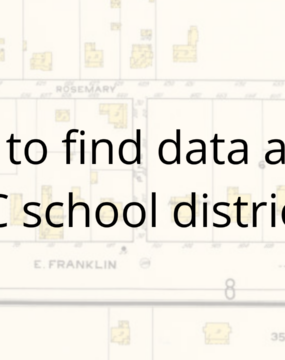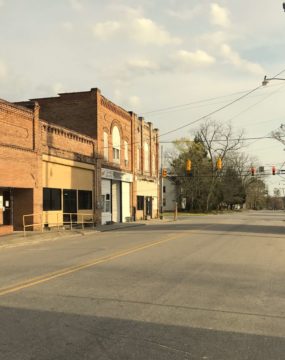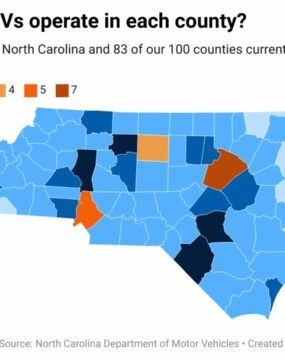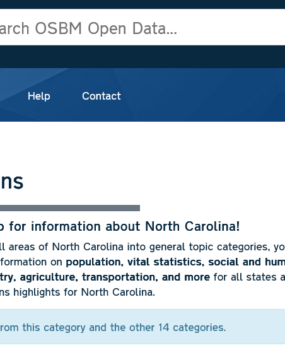Welcome to our blog
Keep up with our latest demographic insights
This blog post is part of a series on how to use the North Carolina Public Schools Statistical Profile. This blog post details how to download different indicators at the school level. We also have tutorials for how to download indicators at the state and district levels. The North Carolina Public Schools Statistical Profile (NCPSSP) is a great resource for obtaining data on North Carolina’s public school students, personnel and finances. This profile is especially…

This blog post is part of a series on how to use the North Carolina Public Schools Statistical Profile. This blog post details how to download different indicators at the state level. We also have tutorials for how to download indicators at the district and school levels. The North Carolina Public Schools Statistical Profile (NCPSSP) is a great resource for obtaining data on North Carolina’s public school students, personnel and finances. This profile is especially…

This blog post is part of a series on how to use the North Carolina Public Schools Statistical Profile. This blog post details how to download different indicators at the district level. We also have tutorials for how to download indicators at the state and school levels. The North Carolina Public Schools Statistical Profile (NCPSSP) is a great resource for obtaining data on North Carolina’s public school students, personnel and finances. This profile is especially…

Thousands of People Moved to the Rural South During the First Year of the Pandemic. Where Did They Come From? by Sarah Melotte, The Daily Yonder August 24, 2023 Out of all the people who moved from larger cities to rural areas in 2021, two-thirds wound up living in the rural South, a Daily Yonder analysis of IRS data shows. Southern rural counties attracted 65% of the people who moved from metropolitan to nonmetropolitan counties…

Many couples today choose to live together prior to getting married, after which the majority of people do get married. In 2021, almost half of all North Carolinians ages 16 or older were currently married, on par with the nation. (This percentage has been steadily decreasing. North Carolina’s currently married population peaked in 1960 – when almost 70% of adults 16 and older in North Carolina were married. That’s the highest percentage since (the Decennial…

There are many reasons for choosing to live with a partner without marrying or prior to getting married, including financial reasons or to test the relationship prior to marriage. In demography, we refer to unmarried romantic partners living together using the term cohabitation. Fifty years ago, it was very rare to live with an unmarried partner. Only 0.1 percent of 18-24-year-olds and 0.2 percent of 25- to 34-year-olds lived with an unmarried partner in…

After this piece was published, the DMV reached out to Carolina Demography to note that they have implemented several efforts to increase availability of appointments. These include providing walk-in appointments after noon, opening more offices at 7am, and having Saturday office hours for peak season. They also note that every driver license office in the state takes only walk-ins every afternoon. Starting with the 2023 election, voters in North Carolina will be asked to show…

Are you curious how North Carolina ranks among the states for statistical categories like population, education, government, employment, agriculture, transportation, and more? The newly-updated 2023 How NC Ranks data tool from the NC State Data Center (NC SDC) and NC Office of State Budget and Management (NC OSBM) provides data visualizations highlighting selected data points for the US and North Carolina Notably, the tool also provides historical data, which allows analysis and comparisons over time.…

The number of babies born each year in North Carolina, as well as the United States, has been dropping. We published a piece on the topic two years ago when provisional numbers were first released about birthrates during the 2020 pandemic. Since then, the final data has been released. (If you read both this piece and the piece we wrote earlier, you’ll notice that percentages are slightly different – that piece was based on…

Achieving a complete and accurate count in the U.S. Census is not simple. The biggest challenge in conducting the census is getting households to mail back or complete their forms online or by phone, a process known as self-response. Higher self-response rates reduce the overall costs of conducting the census. And, when individuals self-respond, the data is more accurate. Before the 2020 Census, Carolina Demography partnered with the NC Counts Coalition to create a map…
Your support is critical to our mission of measuring, understanding, and predicting population change and its impact. Donate to Carolina Demography today.